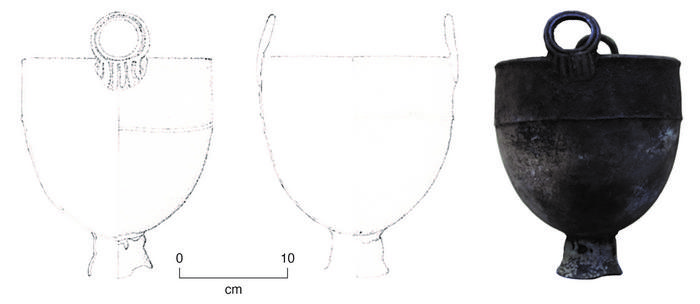A pair of bronze cauldrons from Mongolia were used to collect the blood of animals around 2,700 years ago, new research has found. According to the study authors, the blood was probably processed into sausages that may have resembled black pudding or morcela, which continue to both delight and disgust diners around the world today.
The consumption of blood on the steppes of Bronze Age Eurasia is alluded to in a small number of written sources about the nomadic Xiongnu tribes, who are reported to have drunk the stuff raw. However, researchers suspect that these accounts were probably slightly untruthful and sought to dehumanize the steppe dwellers by painting them as barbaric yobs.
Seeking to gain a better insight into the culinary customs of these ancient pastoralists, researchers analyzed proteins found on a pair of ancient cauldrons that were discovered by herders in northern Mongolia. Results indicated that the vessels were primarily filled with blood belonging to a range of different cattle species and possibly some wild game.
“While it is possible that blood could have been collected for raw consumption or ritual purposes, we believe that it is more likely an aspect of food preparation,” write the study authors. “The use of these vessels as containers for collecting and holding blood aligns well with how blood sausages are made in modern food processing,” they add.

One of the cauldrons, dated to 2,700 years ago.
Image credit: Jamsranjav Bayarsaikhan and Bruce Worden
Putting these findings into perspective, study author Shevan Wilkin explained in a statement that “these parallels with modern times, together with well-founded historical accounts of diet and slaughtering practices in the region, suggest that the processing of blood was a traditional part of Mongolia’s food culture.”
The researchers also detected traces of peptides from a whey protein that is found in yak milk, indicating that Mongolian steppe herders had already domesticated the shaggy brutes by 2,700 years ago.
Currently, there is considerable uncertainty over when exactly yak herding began, with ambiguous Bronze Age rock carvings suggesting that the animals may have been in use by this time, although the creatures depicted in these artworks lack the species’ distinctive bushy tails and long hair, and could therefore represent an entirely different animal.
According to Wilkin, the discovery of these whey proteins helps to settle the debate as it “shows that yaks were domesticated and milked in Mongolia much earlier than previously assumed.”
Regarding the purpose of this milk, the authors say “it remains unclear why these [proteins] were recovered from a vessel that otherwise seemed to have been used primarily for blood collection.”
“It is possible, and even likely that milk, or a processed milk product, was either purposefully or accidentally incorporated into the vessel during the blood collection, cooking, or processing.”
The study is published in the journal Scientific Reports.
Source Link: Bronze Age Blood Cauldrons Were Used For Sausage Production